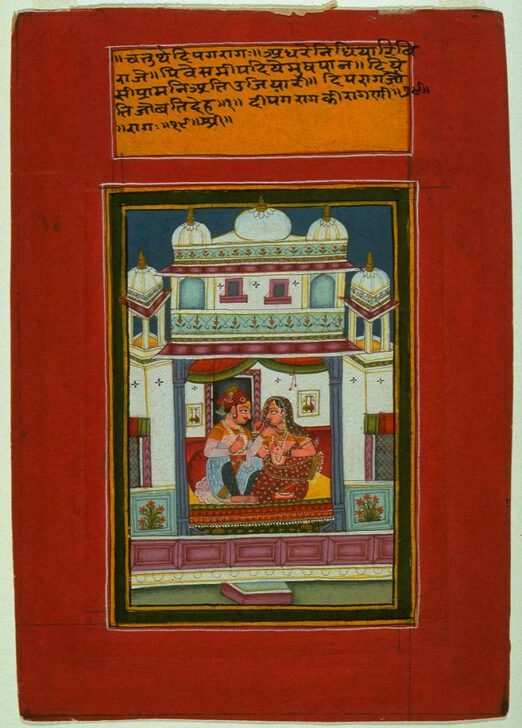Dipak Raga
Indian

Description
March 28, 2009
The classical music of northern India is the raga, a term that literally means “color.” Ragas are associated with particular moods, seasons, and times of day. Poets inspired by the music wrote verses for each of the ragas, and developed a codified system of relations among them, based on analogies to Hindu deities. In these poems, the ragas are personified as male deities or royal figures, and feminine modes, the raginis, are personified as their wives The richly visual imagery of the poetry in turn became the source for ragamala paintings, which flourished at the Hindu and Muslim courts of Central India, Rajasthan, and the Punjab Hills in the sixteenth through nineteenth centuries.
The rulers of Bundi and Kotah commissioned ragamala paintings in great numbers from the seventeenth century onward. In this version, two lovers sit in an elaborate marble palace, decorated with inlaid stone and a domed roof. The figure of the prince, who gently caresses his lover’s chin, is highly individualized and may be a portrait of the patron. Paintings from the Bundi and Kotah courts are prized for their jewel-like colors and polished execution.
(South and Southeast Asia Gallery Rotation, Spring 2009)
Subject Matter:
The rulers of Bundi and Kotah commissioned ragamala paintings in great numbers from the seventeenth century onward. In Bundi-Kotah versions of the Dipak Raga, two lovers sit in an elaborate marble palace, decorated with inlaid stone and a domed roof. The figure of the prince, who gently caresses his lover’s chin, is highly individualized and may be a portrait of the patron.
Physical Description:
Two lovers sit in an elaborate, symmetrical marble palace, decorated with inlaid stone and a domed roof. Inside, a highly individualized prince sits near his lover and caresses her chin. Above the scene is a box containing calligraphic text.
Usage Rights:
If you are interested in using an image for a publication, please visit https://umma.umich.edu/request-image/ for more information and to fill out the online Image Rights and Reproductions Request Form.